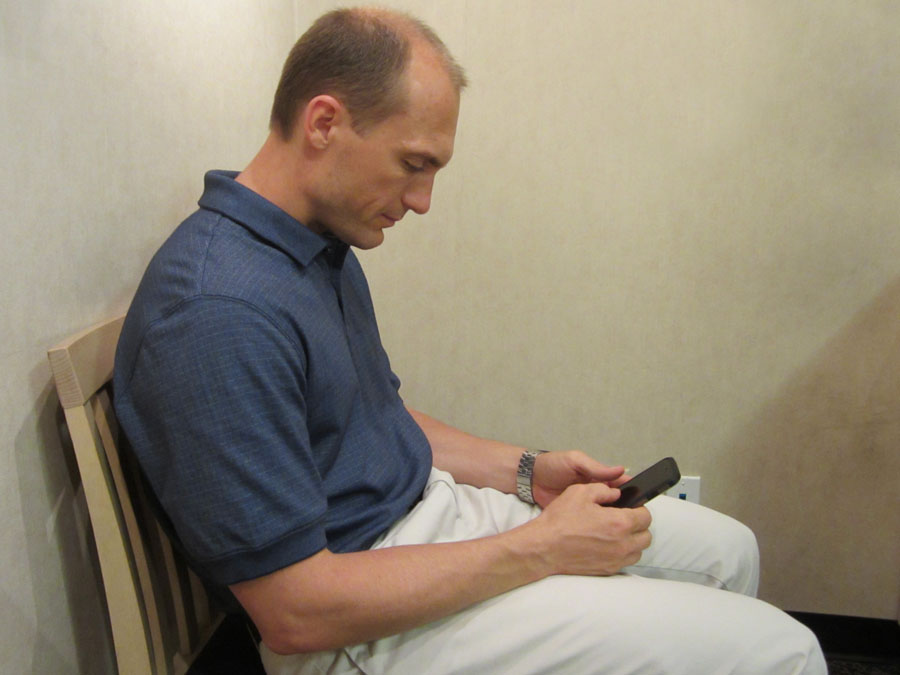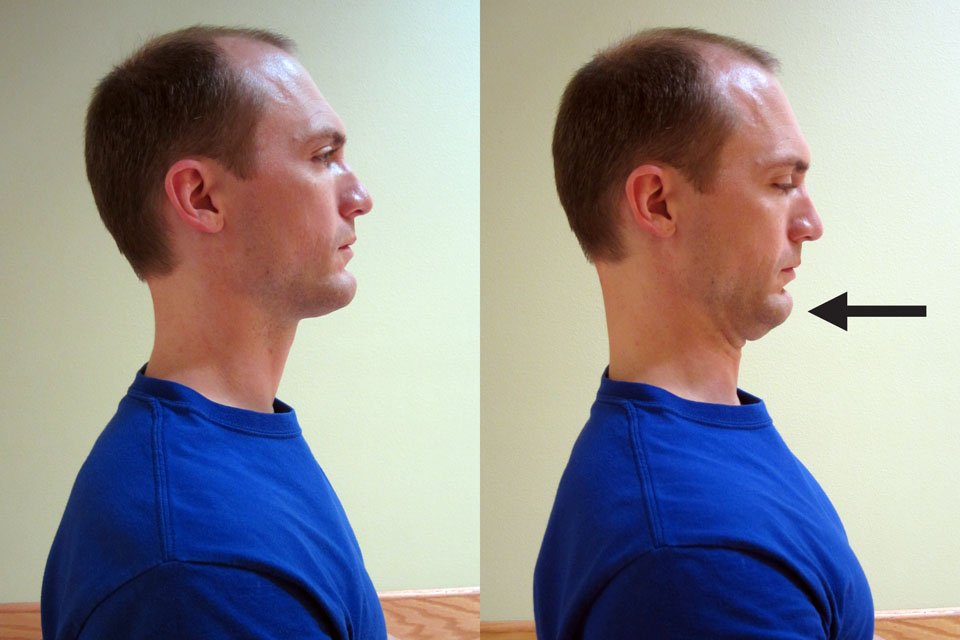With the ever increasing obsession over portable technology devices, it isn’t surprising that cases of “text neck” are also increasing exponentially. Text neck is a term used to describe pain that is felt in the head, cervical spine (neck), and/or thoracic spine (upper back region) from chronically poor posture associated with using mobile technology such as smart phones and E-readers. This tends to go hand in hand with “text thumb” (or what was once called “BlackBerry thumb”) pain.

With over 90% of Americans currently using mobile phones, it’s not surprising that cases of text neck are skyrocketing. People are spending hours hunched over their hand held devices. This is causing chronically poor posture. This forward head and rounded shoulders posture is responsible for causing headache pain, neck pain, upper back pain, and even shoulder pain.
The average sized head weighs approximately 10-12 pounds. Imagine bending over or looking down. At even 30 degrees, the relative weight of the head as felt by the neck and upper back is up to 40 pounds. Increase the flexion to 60 degrees, and the weight goes up to 60 pounds. Over time, the extra strain fatigues the muscles of the neck and thoracic spine. It causes excessive strain on the muscles as well as the ligaments and the discs and joints of the cervical and thoracic spine (ultimately, leading to pain).
When left untreated, you could experience ever increasing levels of pain. Pain in combination with poor posture can place ongoing stress that can lead to pre-mature degeneration of the cervical spine and development of osteoarthritis and other degenerative conditions.
How to Prevent and Treat Text Neck:
- Stop Looking Down. The most obvious treatment for cases of text neck is to address the underlying postural dysfunction. This means that you should stop looking down at your phone or mobile device. Try to keep your devices at eye level. Limit the amount of time spent looking down. If you tend to spend 30-40 minutes at a time looking down at your device, work toward reducing that time in half.
- Use Voice Text Options. To avoid looking down so much, try to use voice text options or hands free options. This can help limit your time spent looking down at the screen.
- Reverse the Position. In today’s society not using a mobile device is a difficult option. Instead of not using a device or never looking down, be proactive by spending time moving in the opposite direction. The neck and upper back are meant to move in many directions. Be sure to extend your neck and thoracic spine frequently throughout the day. Imagine how good it feels to stretch backward while yawning. Perform that motion more frequently and after every prolonged period of looking at your device.
- Perform Cervical Retractions. After looking down for more than a minute, perform cervical retractions (as shown below). Sit up straight, and retract your chin straight back. Repeat 5-10 times.

- Exercise. Keeping the areas of your body which support your arms, neck, and thoracic spine strong is a critical step in preventing text neck pain. Focus on the muscles that extend the neck and thoracic spine as well as stabilize the shoulder girdle (including the muscles of the rotator cuff). Please refer to Rotator Cuff Exercises for two simple exercises that will work your shoulder girdle and rotator cuff muscles while using an exercise band.
- Focus on Your Posture. The chronic forward head with rounded shoulders posture associated with text neck causes excessive muscular tension throughout the cervical spine, upper trapezius region, and mid-thoracic area. Over time, this also leads to muscle weakness and/or dysfunction in the cervical spine and upper thoracic area. Maintaining proper posture allows for the optimal alignment of your spine. Neurologically speaking, this allows for your muscles to down regulate by reducing tension. Poor posture is almost always associated with muscle knots and trigger points. Be sure to vary your positions frequently throughout the day. My Top 8 Stretches to Eliminate Neck, Upper Back, and Shoulder Pain is a downloadable .pdf file with my recommended stretches and exercises to address posture. These simple exercises (with complete instructions and photos) will help you to improve poor posture and can be performed at home.
DOWNLOAD NOW: My Top 8 Stretches to Eliminate Neck, Upper Back, and Shoulder Pain
- Massage. If you are already suffering from trigger points and muscle spasms, massage can be an excellent modality to reduce these symptoms. It’s important to actively and physically address the muscle tension. This is the time to contact a masseuse, physical therapist, athletic trainer or friend who is skillful in body work and massage to relieve the area in spasm. The specific massage technique to use will vary according to your preference. Massage techniques range from a light relaxing massage to a deep tissue massage or utilization of acupressure points. This can also be an effective prevention strategy.
- Foam roller. The foam roller allows you to perform self-massage and tissue mobilization. Utilize a foam roller on a daily basis in order to avoid neck and upper back pain. Please refer to the following posts for more information: Foam Rolling For Rehabilitation and 5 Ways to Improve Range-Of-Motion. I highly recommend a foam roller to help aid in your recovery.
- Acupuncture. I am personally a big fan of acupuncture. It is very useful in treating all kinds of medical conditions. It can be particularly effective in treating headaches, muscle trigger points, muscle cramps, spasms, and pain as it addresses the issues on multiple layers. Acupuncture directly stimulates the muscle by affecting the nervous system response to the muscle while producing a general sense of well-being and relaxation.
- Manual Therapy. A physical therapist or chiropractor can use manual therapy techniques which can be beneficial in reducing pain and addressing some of the mechanical causes. However, manual therapy is a passive treatment. For long term treatment and prevention, an active approach needs to be taken. I would encourage you to perform proper exercises to insure that you have adequate cervical and upper thoracic strength and mobility. Also, address any precipitating factors (such as poor posture).
- Medications. Medications can be an effective short term solution for pain, but I strongly encourage you to transition off of medications over time. In some cases, prescription medications may be used initially to help you tolerate the pain as you work toward prevention. Please speak to your physician regarding prescription options.
- Speak with your Physical Therapist (PT) or Physician (MD). If you are suffering with headache and muscle tension/pain, there are options. Please speak to your medical provider to determine if other causes are contributing to the problem. The American Physical Therapy Association (APTA) offers a wonderful resource to help find a physical therapist in your area. In most states, you can seek physical therapy advice without a medical doctor’s referral (although it may be a good idea to hear your physician’s opinion as well).
Whether you suffer from text neck or you’re experiencing pain from chronic poor postures, these prevention and treatment strategies will help you overcome the discomfort. Begin by implementing one or two of these treatment tips, and then assess how well they worked for you. If the technique helped, continue with it and then implement another strategy.
Which strategies can you implement in order to avoid and/or alleviate the discomfort of text neck? Please share below.
If you have a question that you would like featured in an upcoming blog post, please comment below or submit your question to contact@thePhysicalTherapyAdvisor.com. Be sure to join our growing community on Facebook by liking The Physical Therapy Advisor!
